Leadership, Motivation, and Performance Management Strategies Essay
VerifiedAdded on 2023/06/15
|12
|941
|237
Essay
AI Summary
This essay provides an overview of leadership and management approaches, focusing on motivational theories such as Maslow's Hierarchy of Needs and Skinner's reinforcement theory. It evaluates the application of performance management approaches, particularly within the context of Marks and Spencer, highlighting the importance of establishing goals and fostering a positive workplace environment. The essay recommends strategies for continuous improvement, including training and development programs, and discusses the integration of intrinsic and extrinsic motivation to achieve organizational objectives. The conclusion emphasizes the direct link between employee motivation and performance, advocating for effective leadership and management approaches to boost morale and ensure the achievement of organizational goals.

Leadership and
Management
Management
Paraphrase This Document
Need a fresh take? Get an instant paraphrase of this document with our AI Paraphraser
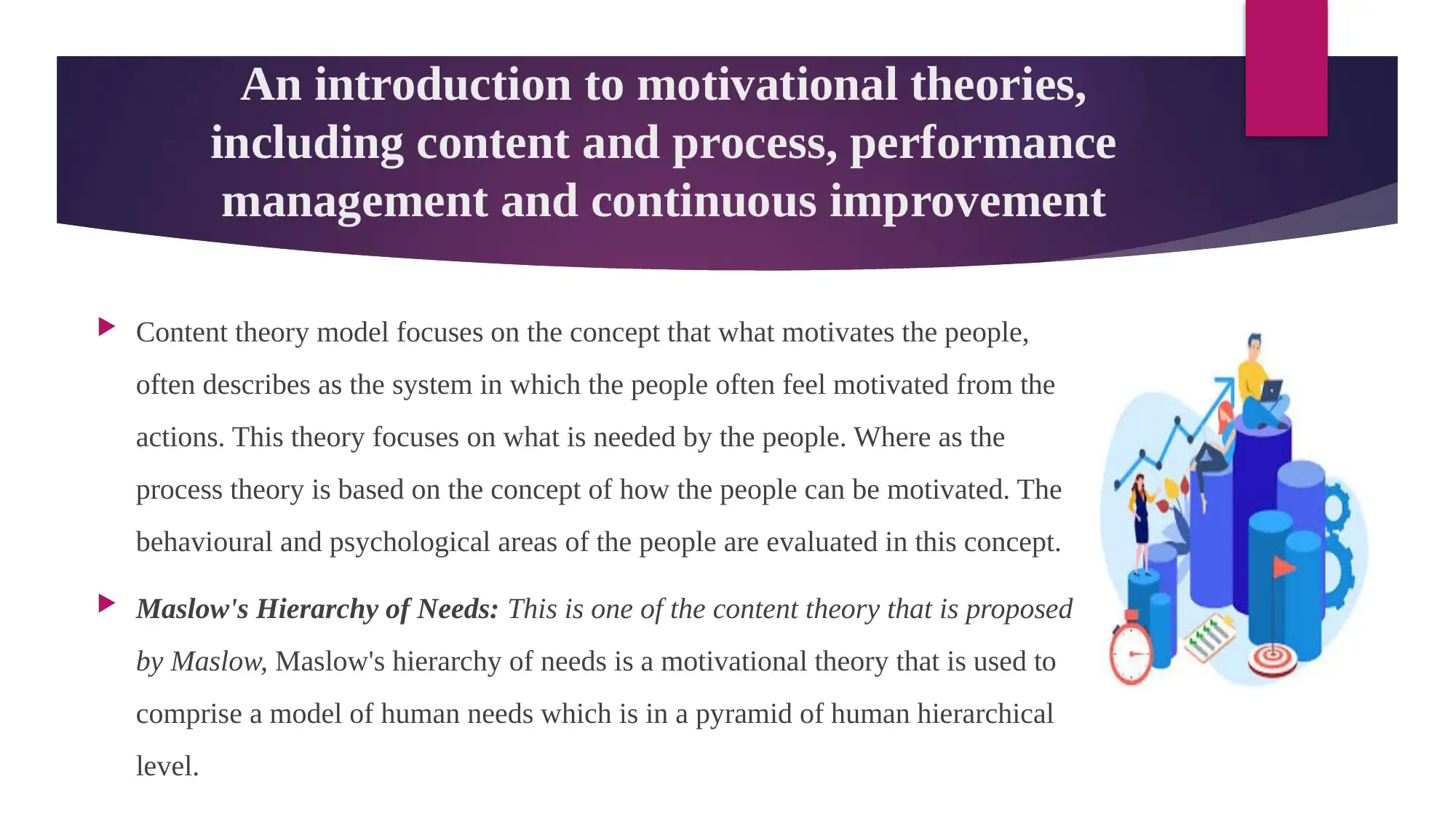
An introduction to motivational theories,
including content and process, performance
management and continuous improvement
Content theory model focuses on the concept that what motivates the people,
often describes as the system in which the people often feel motivated from the
actions. This theory focuses on what is needed by the people. Where as the
process theory is based on the concept of how the people can be motivated. The
behavioural and psychological areas of the people are evaluated in this concept.
Maslow's Hierarchy of Needs: This is one of the content theory that is proposed
by Maslow, Maslow's hierarchy of needs is a motivational theory that is used to
comprise a model of human needs which is in a pyramid of human hierarchical
level.
including content and process, performance
management and continuous improvement
Content theory model focuses on the concept that what motivates the people,
often describes as the system in which the people often feel motivated from the
actions. This theory focuses on what is needed by the people. Where as the
process theory is based on the concept of how the people can be motivated. The
behavioural and psychological areas of the people are evaluated in this concept.
Maslow's Hierarchy of Needs: This is one of the content theory that is proposed
by Maslow, Maslow's hierarchy of needs is a motivational theory that is used to
comprise a model of human needs which is in a pyramid of human hierarchical
level.
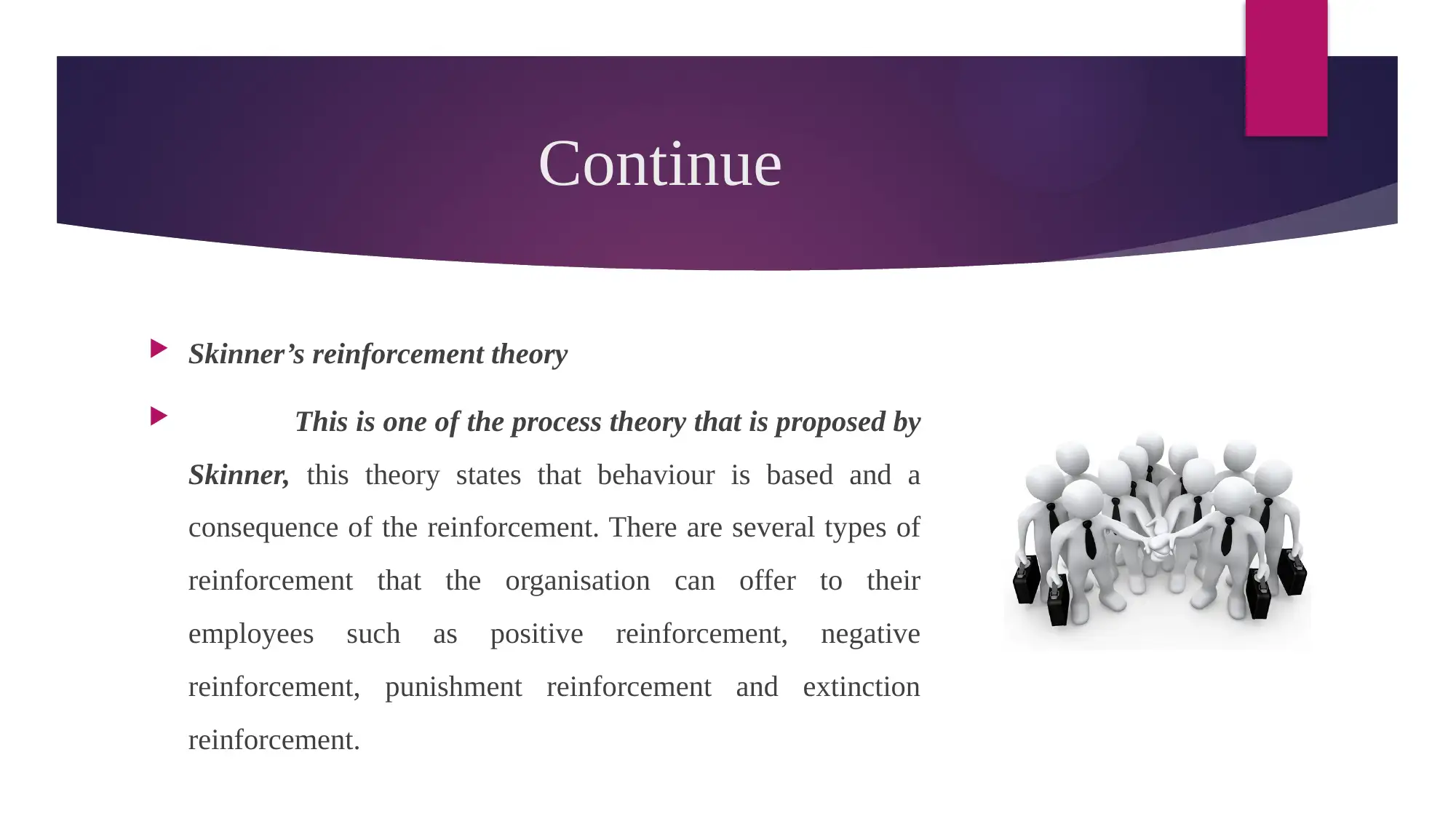
Continue
Skinner’s reinforcement theory
This is one of the process theory that is proposed by
Skinner, this theory states that behaviour is based and a
consequence of the reinforcement. There are several types of
reinforcement that the organisation can offer to their
employees such as positive reinforcement, negative
reinforcement, punishment reinforcement and extinction
reinforcement.
Skinner’s reinforcement theory
This is one of the process theory that is proposed by
Skinner, this theory states that behaviour is based and a
consequence of the reinforcement. There are several types of
reinforcement that the organisation can offer to their
employees such as positive reinforcement, negative
reinforcement, punishment reinforcement and extinction
reinforcement.
⊘ This is a preview!⊘
Do you want full access?
Subscribe today to unlock all pages.

Trusted by 1+ million students worldwide
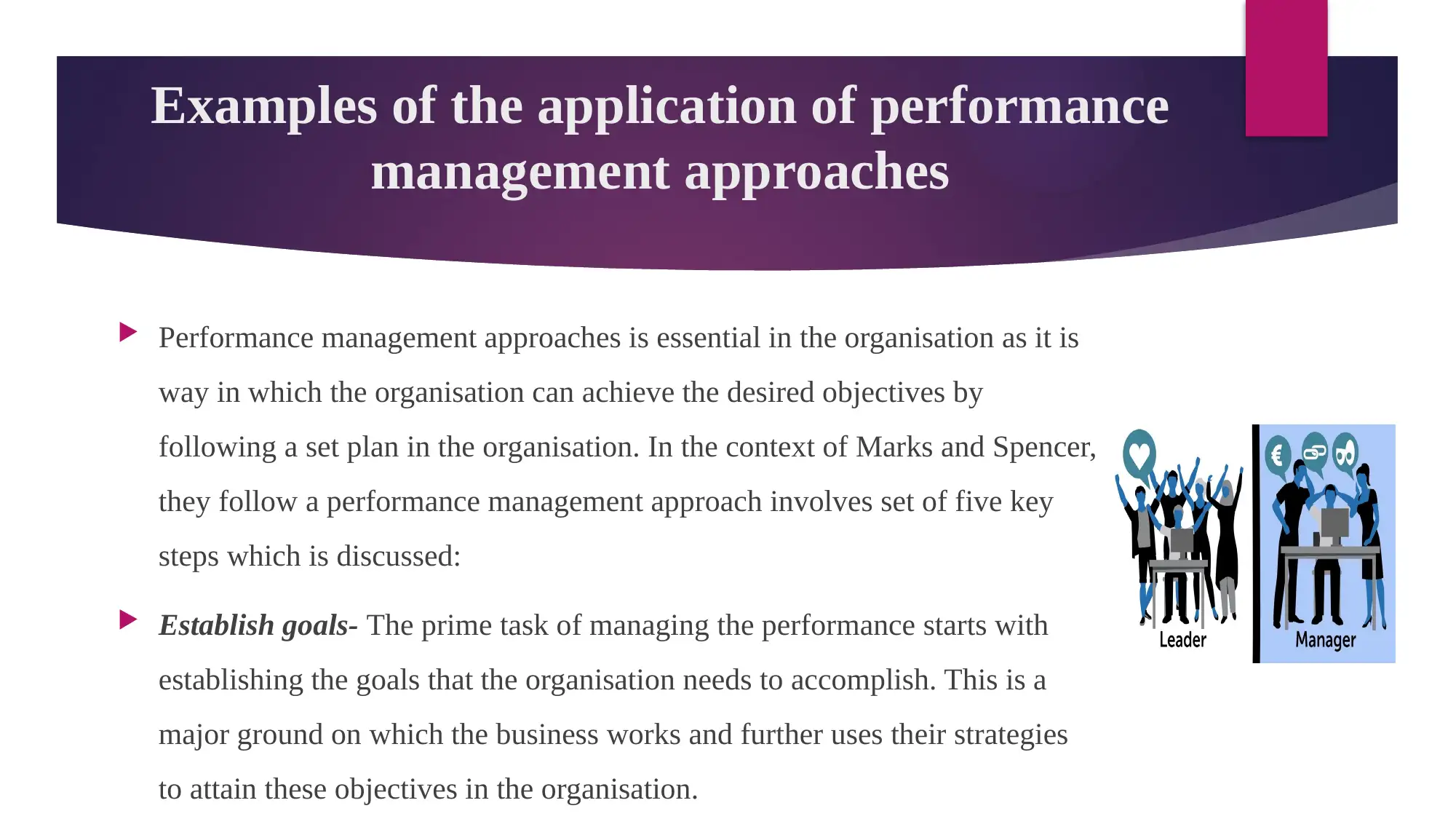
Examples of the application of performance
management approaches
Performance management approaches is essential in the organisation as it is
way in which the organisation can achieve the desired objectives by
following a set plan in the organisation. In the context of Marks and Spencer,
they follow a performance management approach involves set of five key
steps which is discussed:
Establish goals- The prime task of managing the performance starts with
establishing the goals that the organisation needs to accomplish. This is a
major ground on which the business works and further uses their strategies
to attain these objectives in the organisation.
management approaches
Performance management approaches is essential in the organisation as it is
way in which the organisation can achieve the desired objectives by
following a set plan in the organisation. In the context of Marks and Spencer,
they follow a performance management approach involves set of five key
steps which is discussed:
Establish goals- The prime task of managing the performance starts with
establishing the goals that the organisation needs to accomplish. This is a
major ground on which the business works and further uses their strategies
to attain these objectives in the organisation.
Paraphrase This Document
Need a fresh take? Get an instant paraphrase of this document with our AI Paraphraser
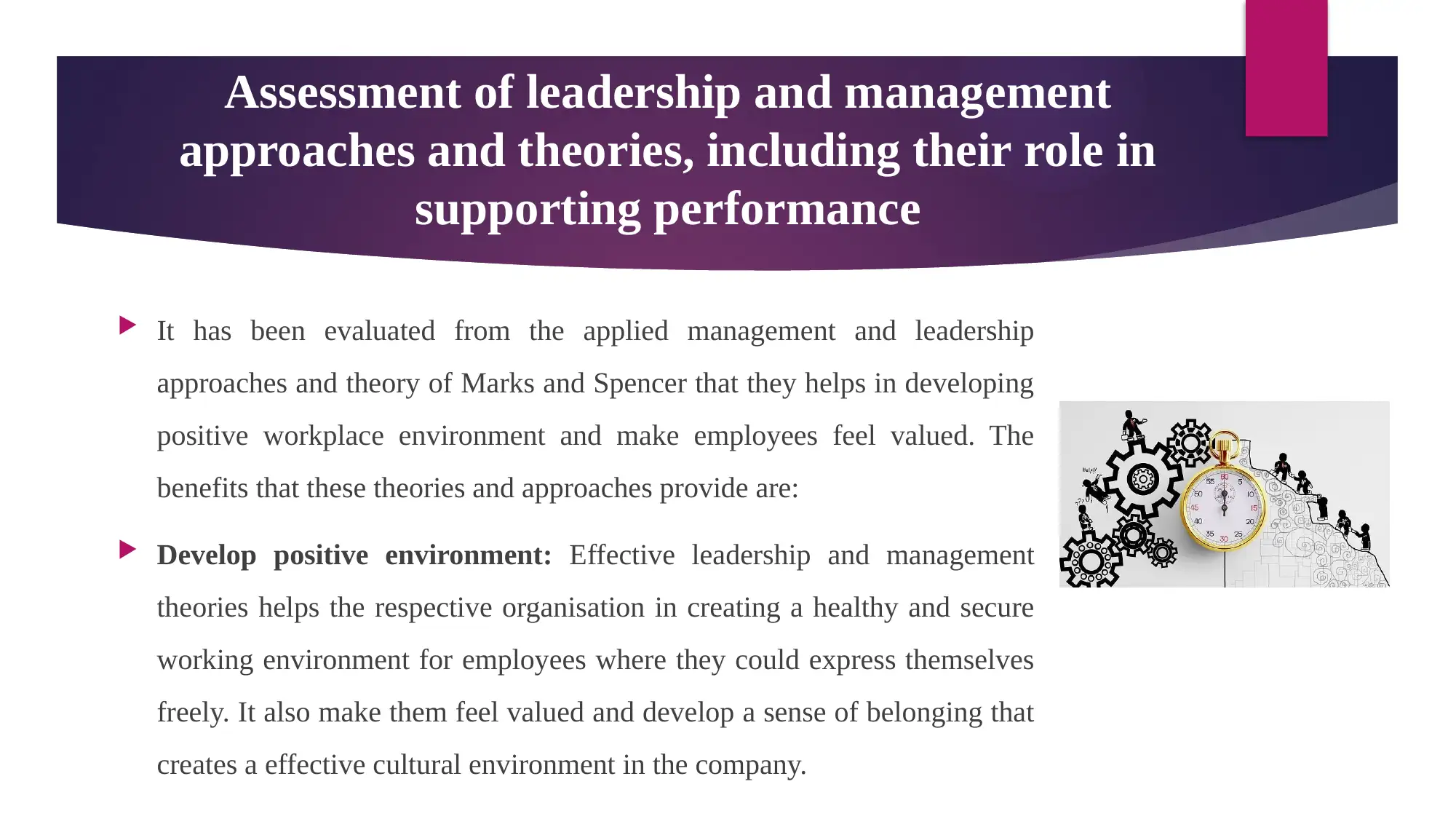
Assessment of leadership and management
approaches and theories, including their role in
supporting performance
It has been evaluated from the applied management and leadership
approaches and theory of Marks and Spencer that they helps in developing
positive workplace environment and make employees feel valued. The
benefits that these theories and approaches provide are:
Develop positive environment: Effective leadership and management
theories helps the respective organisation in creating a healthy and secure
working environment for employees where they could express themselves
freely. It also make them feel valued and develop a sense of belonging that
creates a effective cultural environment in the company.
approaches and theories, including their role in
supporting performance
It has been evaluated from the applied management and leadership
approaches and theory of Marks and Spencer that they helps in developing
positive workplace environment and make employees feel valued. The
benefits that these theories and approaches provide are:
Develop positive environment: Effective leadership and management
theories helps the respective organisation in creating a healthy and secure
working environment for employees where they could express themselves
freely. It also make them feel valued and develop a sense of belonging that
creates a effective cultural environment in the company.
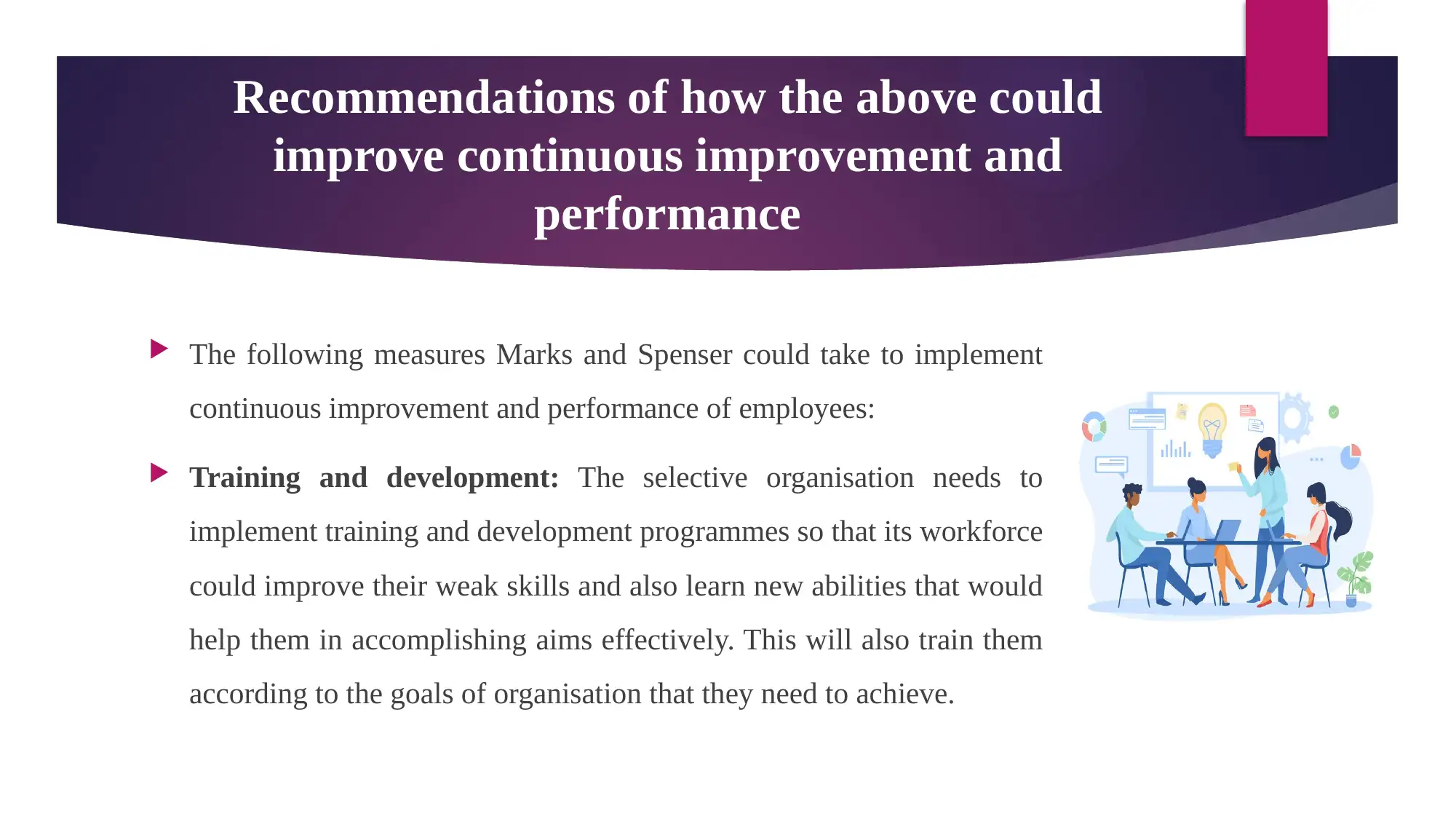
Recommendations of how the above could
improve continuous improvement and
performance
The following measures Marks and Spenser could take to implement
continuous improvement and performance of employees:
Training and development: The selective organisation needs to
implement training and development programmes so that its workforce
could improve their weak skills and also learn new abilities that would
help them in accomplishing aims effectively. This will also train them
according to the goals of organisation that they need to achieve.
improve continuous improvement and
performance
The following measures Marks and Spenser could take to implement
continuous improvement and performance of employees:
Training and development: The selective organisation needs to
implement training and development programmes so that its workforce
could improve their weak skills and also learn new abilities that would
help them in accomplishing aims effectively. This will also train them
according to the goals of organisation that they need to achieve.
⊘ This is a preview!⊘
Do you want full access?
Subscribe today to unlock all pages.

Trusted by 1+ million students worldwide
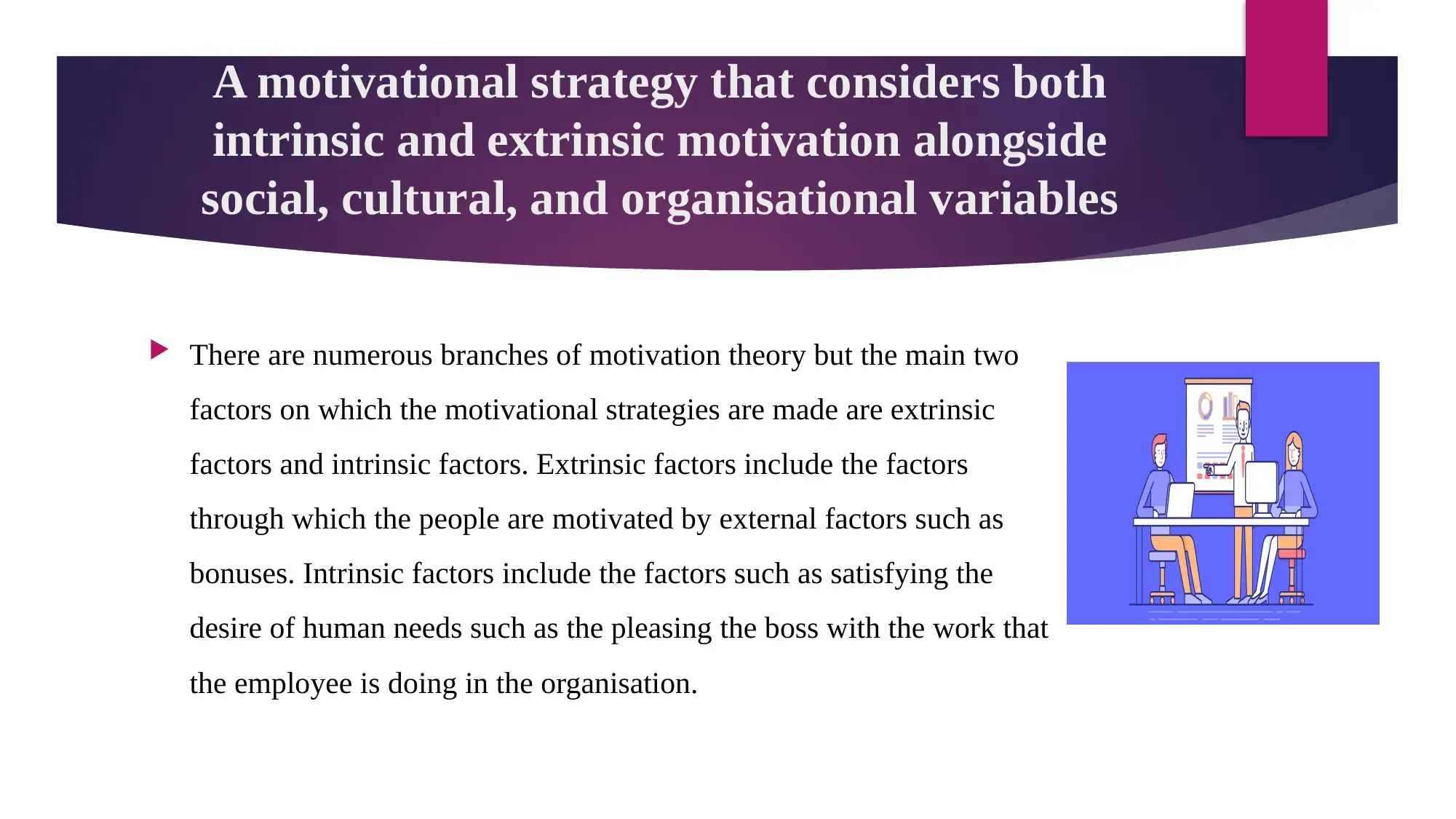
A motivational strategy that considers both
intrinsic and extrinsic motivation alongside
social, cultural, and organisational variables
There are numerous branches of motivation theory but the main two
factors on which the motivational strategies are made are extrinsic
factors and intrinsic factors. Extrinsic factors include the factors
through which the people are motivated by external factors such as
bonuses. Intrinsic factors include the factors such as satisfying the
desire of human needs such as the pleasing the boss with the work that
the employee is doing in the organisation.
intrinsic and extrinsic motivation alongside
social, cultural, and organisational variables
There are numerous branches of motivation theory but the main two
factors on which the motivational strategies are made are extrinsic
factors and intrinsic factors. Extrinsic factors include the factors
through which the people are motivated by external factors such as
bonuses. Intrinsic factors include the factors such as satisfying the
desire of human needs such as the pleasing the boss with the work that
the employee is doing in the organisation.
Paraphrase This Document
Need a fresh take? Get an instant paraphrase of this document with our AI Paraphraser
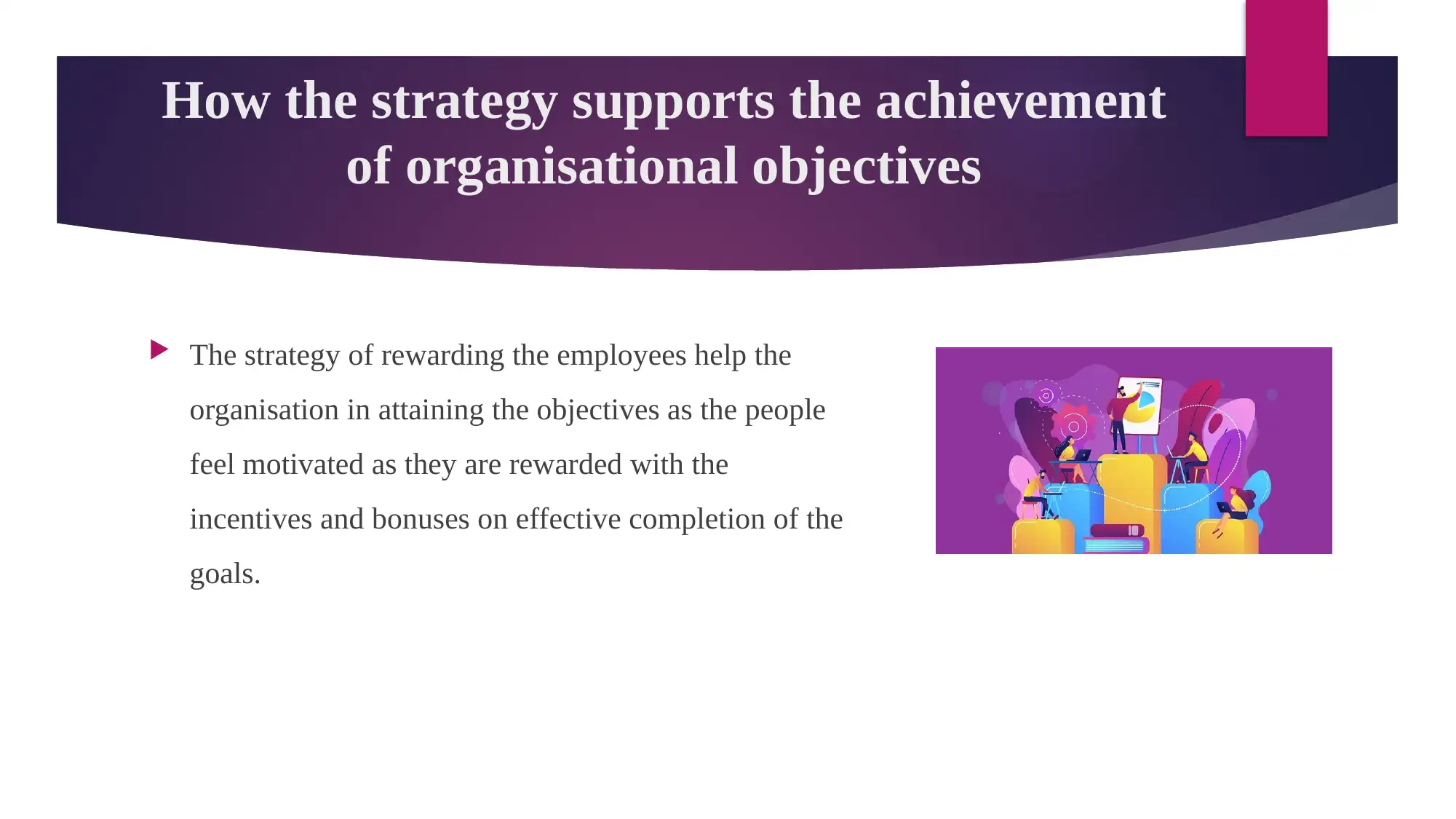
How the strategy supports the achievement
of organisational objectives
The strategy of rewarding the employees help the
organisation in attaining the objectives as the people
feel motivated as they are rewarded with the
incentives and bonuses on effective completion of the
goals.
of organisational objectives
The strategy of rewarding the employees help the
organisation in attaining the objectives as the people
feel motivated as they are rewarded with the
incentives and bonuses on effective completion of the
goals.
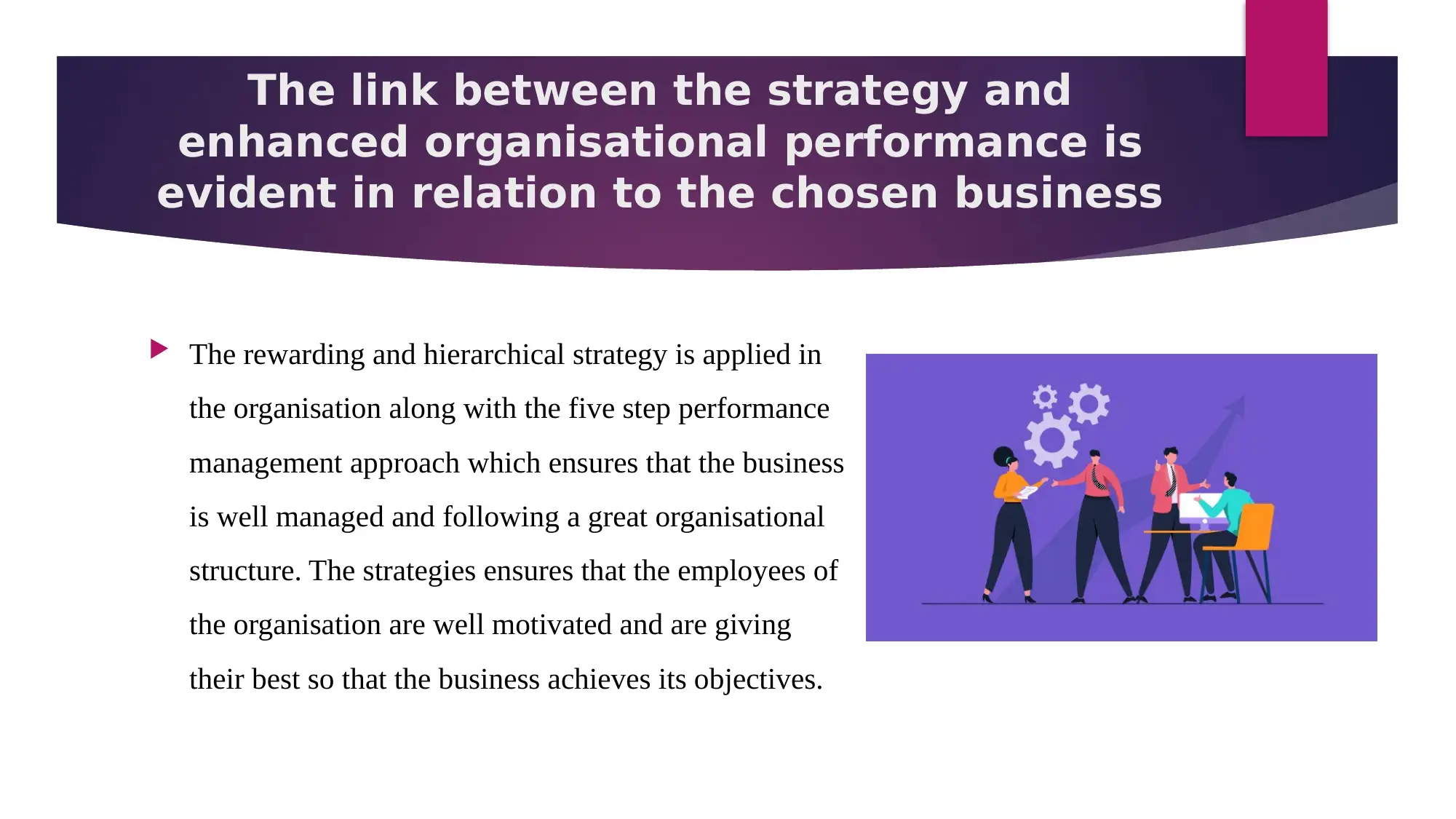
The link between the strategy and
enhanced organisational performance is
evident in relation to the chosen business
The rewarding and hierarchical strategy is applied in
the organisation along with the five step performance
management approach which ensures that the business
is well managed and following a great organisational
structure. The strategies ensures that the employees of
the organisation are well motivated and are giving
their best so that the business achieves its objectives.
enhanced organisational performance is
evident in relation to the chosen business
The rewarding and hierarchical strategy is applied in
the organisation along with the five step performance
management approach which ensures that the business
is well managed and following a great organisational
structure. The strategies ensures that the employees of
the organisation are well motivated and are giving
their best so that the business achieves its objectives.
⊘ This is a preview!⊘
Do you want full access?
Subscribe today to unlock all pages.

Trusted by 1+ million students worldwide
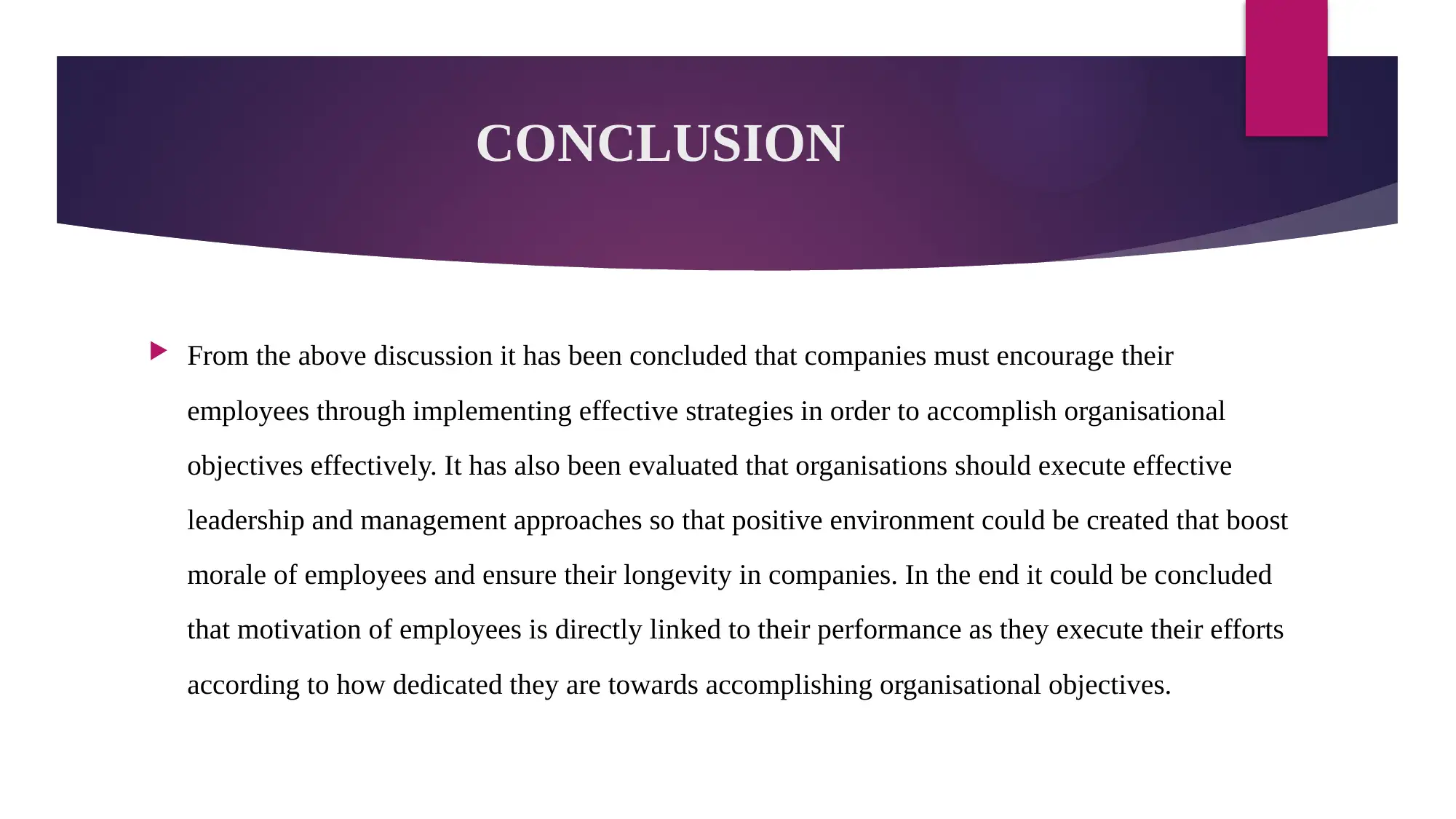
CONCLUSION
From the above discussion it has been concluded that companies must encourage their
employees through implementing effective strategies in order to accomplish organisational
objectives effectively. It has also been evaluated that organisations should execute effective
leadership and management approaches so that positive environment could be created that boost
morale of employees and ensure their longevity in companies. In the end it could be concluded
that motivation of employees is directly linked to their performance as they execute their efforts
according to how dedicated they are towards accomplishing organisational objectives.
From the above discussion it has been concluded that companies must encourage their
employees through implementing effective strategies in order to accomplish organisational
objectives effectively. It has also been evaluated that organisations should execute effective
leadership and management approaches so that positive environment could be created that boost
morale of employees and ensure their longevity in companies. In the end it could be concluded
that motivation of employees is directly linked to their performance as they execute their efforts
according to how dedicated they are towards accomplishing organisational objectives.
Paraphrase This Document
Need a fresh take? Get an instant paraphrase of this document with our AI Paraphraser
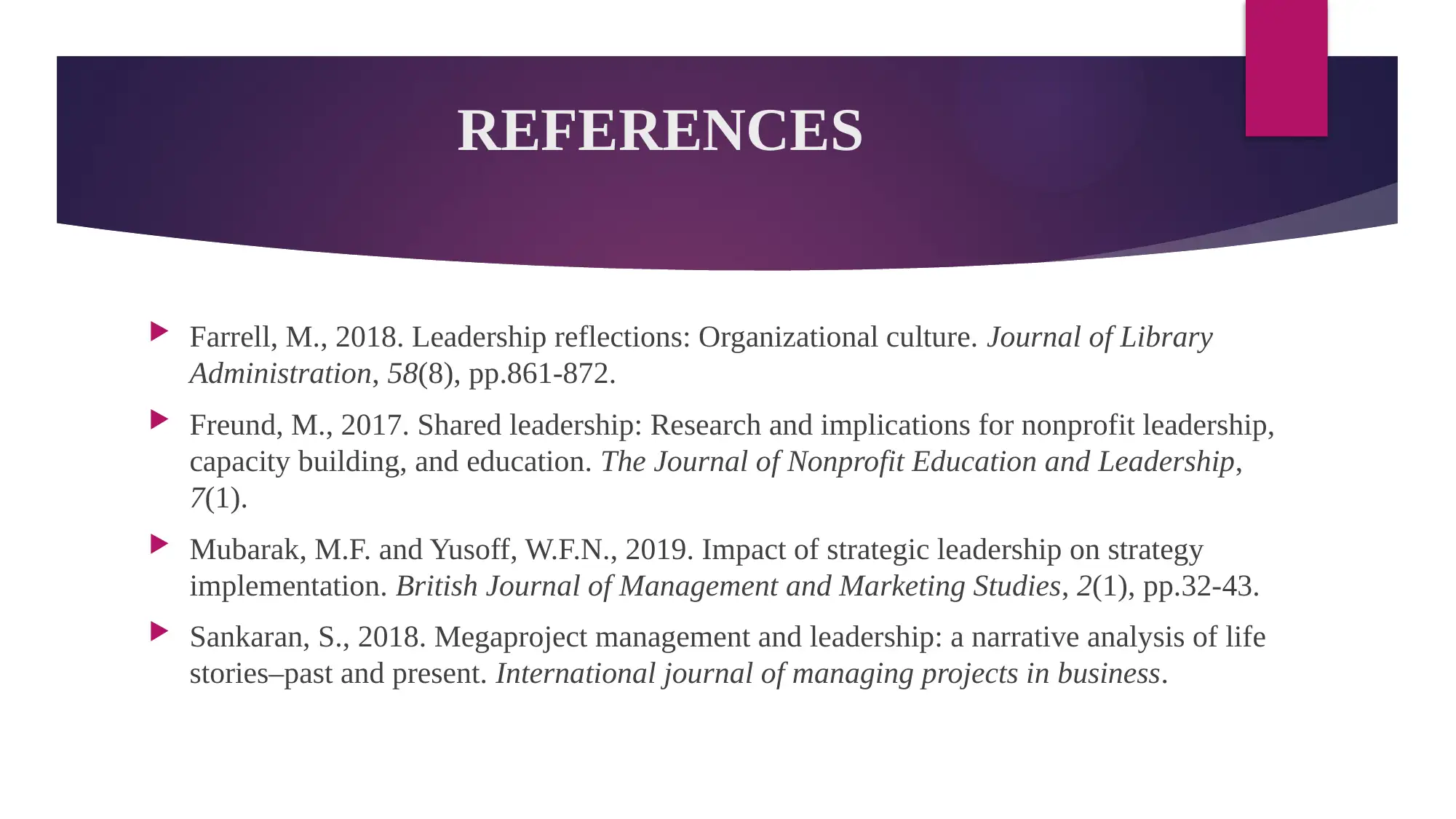
REFERENCES
Farrell, M., 2018. Leadership reflections: Organizational culture. Journal of Library
Administration, 58(8), pp.861-872.
Freund, M., 2017. Shared leadership: Research and implications for nonprofit leadership,
capacity building, and education. The Journal of Nonprofit Education and Leadership,
7(1).
Mubarak, M.F. and Yusoff, W.F.N., 2019. Impact of strategic leadership on strategy
implementation. British Journal of Management and Marketing Studies, 2(1), pp.32-43.
Sankaran, S., 2018. Megaproject management and leadership: a narrative analysis of life
stories–past and present. International journal of managing projects in business.
Farrell, M., 2018. Leadership reflections: Organizational culture. Journal of Library
Administration, 58(8), pp.861-872.
Freund, M., 2017. Shared leadership: Research and implications for nonprofit leadership,
capacity building, and education. The Journal of Nonprofit Education and Leadership,
7(1).
Mubarak, M.F. and Yusoff, W.F.N., 2019. Impact of strategic leadership on strategy
implementation. British Journal of Management and Marketing Studies, 2(1), pp.32-43.
Sankaran, S., 2018. Megaproject management and leadership: a narrative analysis of life
stories–past and present. International journal of managing projects in business.

Thank-You
⊘ This is a preview!⊘
Do you want full access?
Subscribe today to unlock all pages.

Trusted by 1+ million students worldwide
1 out of 12
Related Documents
Your All-in-One AI-Powered Toolkit for Academic Success.
+13062052269
info@desklib.com
Available 24*7 on WhatsApp / Email
![[object Object]](/_next/static/media/star-bottom.7253800d.svg)
Unlock your academic potential
Copyright © 2020–2025 A2Z Services. All Rights Reserved. Developed and managed by ZUCOL.




